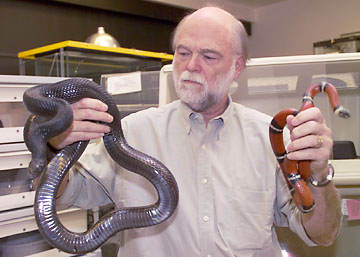Harry Greene: A passion for 'icons of danger, life and death'
By Susan S. Lang

ITHACA, N.Y. -- More than 40 years of snake hunting have taken Harry Greene, professor of ecology and evolutionary biology, to 18 countries on six continents. He has slogged through snake-infested jungles, forests, deserts, rain forests, swamps and savannas, camping for weeks at a time. He has squeezed out prey from the guts of slithering serpents to see what they eat and implanted tiny radio transmitters into their body cavities to track where they go. And although he has handled hundreds, if not thousands, of specimens and has been bitten hundreds of times, only once was it by a venomous snake. And that was when he was an inexperienced 17-year-old.
Greene is one of the world's leading snake experts and a popular Cornell professor who teaches the nonmajors basic course in biology and a course in herpetology, the study of reptiles and amphibians, for which he keeps a collection of some 50 live snakes. He is also the co-faculty curator of amphibians and reptiles in the Cornell Museum of Vertebrates (a collection of 35,000 specimens) with his wife, Kelly Zamudio, an associate professor in the same department.
Fascinated by reptiles as early as age 7, Greene recalls reading the same books on snakes and lizards over and over again at the 13 different schools he attended while his father was in the U.S. Air Force. It wasn't until Greene was 13, though, that his father took him to a seminar given by a prominent reptile ecologist whom Greene decided he wanted to emulate -- and, indeed, later consulted about a career in biology. Greene went on to publish two scientific papers while he was still in high school and another four in college (to date he has published about 150).
"But I was such a nerd in high school; I never noticed girls," said Greene. But he noticed them in college, so much so that by the end of his sophomore year at Southwest Texas State University, he had a cumulative 1.89 GPA and nearly flunked out. He got serious, however, once he transferred to Texas Wesleyan College, where he lived over a funeral home and drove an ambulance as a full-time job. "I saw a lot of horrible things," said Greene, recalling fatal car crashes and how he had given CPR to a dying girl. On the other hand, he once delivered a baby to an 18-year-old woman.
Ambulance driving was gratifying, however, for it saved lives, he said, possibly even his own. Drafted into the Army just after graduation at the height of the Vietnam War, Greene was one of the few men from his basic training unit who didn't go to Vietnam. Instead, he worked as a medic for two years in Germany, visiting herpetariums and museums whenever he could to study more snakes.
After the Army, Greene earned an M.A. degree at the University of Texas at Arlington (1973), and just as he finished a Ph.D. in zoology at the University of Tennessee (1977), he was chosen from 600 applicants to interview at Cornell. His sample lecture, however, was such a "colossal flop" that he didn't get the job. But after 20 years as a professor of integrative biology at the University of California-Berkeley, Cornell came around again in 1999, this time offering Greene and his wife, who had recently earned her Ph.D., tenure-track positions in the same department.
Greene has brought to Ithaca a passion for venomous snakes, creatures that many people fear. "With venomous snakes we contemplate violence and mortality without implication of real evil, devoid of anthropocentric traps laid by fur, feathers and facial expressions," Greene wrote in the epilogue to his award-winning book, "Snakes: The Evolution of Mystery in Nature" (University of California Press, Berkeley, 1997). The 351-page book is a tribute to the beauty and mystique of the reptiles, combining personal essays and natural history with more than 200 stunning photographs.
After seeing so much violence and death in his youth, Greene contemplates venomous snakes as he considers mortality, death and evil. "To me, venomous snakes are personal icons of danger, life and death -- as if in that crystalline moment when the fangs pierce another creature, I might finally understand my own fears and losses," says the bearded and burly herpetologist whose areas of specialty are behavior and ecology, mimicry, conservation and evolutionary biology.
He has dissected the stomachs of hundreds of dead snakes to study their eating behaviors, but his recent work, using radio telemetry to track the same snakes for years at a time, focused on the social behavior of rattlesnakes. He has observed, for example, that females typically fast during winter hibernation and during their subsequent spring pregnancies. After giving birth, although the female hasn't eaten for 10 months, she fasts for another 10 days to protect her vulnerable young until they are ready to strike out on their own.
Greene also works hard to muster more financial and curricular support for descriptive natural history, such as the ecology and behavior of organisms. "People will only care more, pay more and even sacrifice for those things that they understand, so we need to establish biological diversity, ecology, behavior and conservation as among the core components of scientific literacy," stresses Greene in a recent scientific paper published in Trends in Ecology and Evolution (January 2005).
And that's why diversity is such a strong theme in Greene's Biology 109 course, which typically has up to 350 students each fall, many of them freshmen. "Being a professor is pretty much my life," said Greene, who has won three teaching awards. "I love teaching and studying biology. And since I have no children of my own, my students are my kids; I just love watching them go through such incredible growth from their freshman to their senior years."
Media Contact
Get Cornell news delivered right to your inbox.
Subscribe